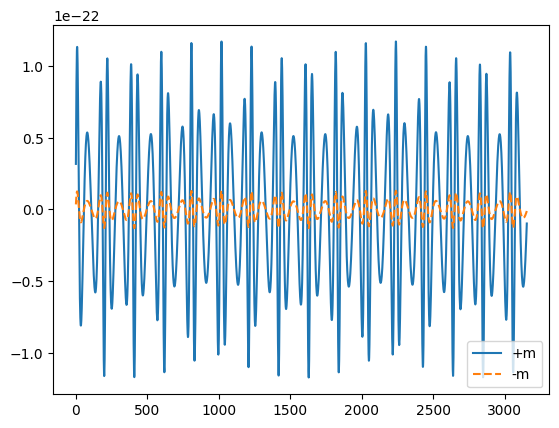Mode Selection
The mode selection module is paramount to the computational efficiency of this model. Below we show how we perform this selection operation by moving from a set of amplitudes to only those that contribute.
Mode selection by power contribution
[1]:
import numpy as np
import matplotlib.pyplot as plt
import few
from few.trajectory.inspiral import EMRIInspiral
from few.trajectory.ode import SchwarzEccFlux
from few.amplitude.romannet import RomanAmplitude
from few.utils.ylm import GetYlms
from few.utils.modeselector import ModeSelector
# tune few configuration
cfg_set = few.get_config_setter(reset=True)
# Uncomment if you want to force CPU or GPU usage
# Leave commented to let FEW automatically select the best available hardware
# - To force CPU usage:
# cfg_set.enable_backends("cpu")
# - To force GPU usage with CUDA 12.x
# cfg_set.enable_backends("cuda12x", "cpu")
# - To force GPU usage with CUDA 11.x
# cfg_set.enable_backends("cuda11x", "cpu")
cfg_set.set_log_level("info");
[4]:
# first, lets get amplitudes for a trajectory
traj = EMRIInspiral(func=SchwarzEccFlux)
# parameters
m1 = 1e5
m2 = 1e1
p0 = 10.0
e0 = 0.7
theta = np.pi / 3.0
phi = np.pi / 2.0
t, p, e, x, Phi_phi, Phi_theta, Phi_r = traj(m1, m2, 0.0, p0, e0, 1.0)
# get amplitudes along trajectory
amp = RomanAmplitude()
# Schwarzschild
a = 0.0
teuk_modes = amp(a, p, e, x)
# get ylms
ylm_gen = GetYlms(include_minus_m=False)
ylms = ylm_gen(amp.unique_l, amp.unique_m, theta, phi).copy()[amp.inverse_lm]
# select modes
mode_selector = ModeSelector(
amp.l_arr_no_mask, amp.m_arr_no_mask, amp.n_arr_no_mask, force_backend="cpu"
)
mode_selection_threshold = 1e-1 # tolerance on mode contribution to total power
modeinds = [amp.l_arr, amp.m_arr, amp.n_arr]
(teuk_modes_in, ylms_in, ls, ms, ns) = mode_selector(
teuk_modes, ylms, modeinds, mode_selection_threshold=mode_selection_threshold
)
print(
"We reduced the mode content from {} modes to {} modes.".format(
teuk_modes.shape[1], teuk_modes_in.shape[1]
)
)
We reduced the mode content from 3843 modes to 43 modes.
Mode selection by noise-weighted power contribution
Modes can also be weighted by a Power Spectral Density (PSD) function from your favorite sensitivity curve.
[7]:
from few.summation.interpolatedmodesum import CubicSplineInterpolant
from few import get_file_manager
# produce sensitivity function
noise = np.genfromtxt(get_file_manager().get_file("LPA.txt"), names=True)
f, PSD = (
np.asarray(noise["f"], dtype=np.float64),
np.asarray(noise["ASD"], dtype=np.float64) ** 2,
)
sens_fn = CubicSplineInterpolant(f, PSD)
# select modes with noise weighting
# provide sensitivity function kwarg
mode_selector_noise_weighted = ModeSelector(
amp.l_arr_no_mask, amp.m_arr_no_mask, amp.n_arr_no_mask, sensitivity_fn=sens_fn
)
mode_selection_threshold = 1e-2 # tolerance on mode contribution to total power
fund_freq_args = (m1, m2, a, p, e, x, t)
modeinds = [amp.l_arr, amp.m_arr, amp.n_arr]
(teuk_modes_in, ylms_in, ls, ms, ns) = mode_selector_noise_weighted(
teuk_modes, ylms, modeinds, fund_freq_args=fund_freq_args, mode_selection_threshold=mode_selection_threshold
)
print(
"We reduced the mode content from {} modes to {} modes when using noise-weighting.".format(
teuk_modes.shape[1], teuk_modes_in.shape[1]
)
)
# plot histogram of modes
plt.figure()
plt.hist(ns, bins=100, label="n")
plt.xlabel("n")
plt.ylabel("Number of radial modes")
plt.show()
plt.figure()
plt.hist(ms, bins=100, label="n")
plt.xlabel("m")
plt.ylabel("Number of azimuthal modes")
plt.show()
(CubicSplineInterpolant) Warning: New t array outside bounds of input t array. These points are filled with edge values.
We reduced the mode content from 3843 modes to 99 modes when using noise-weighting.
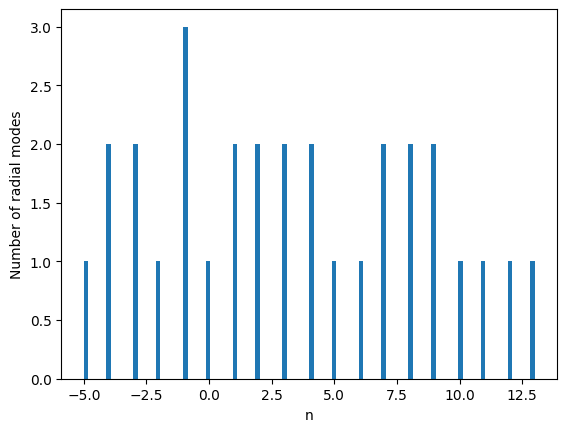
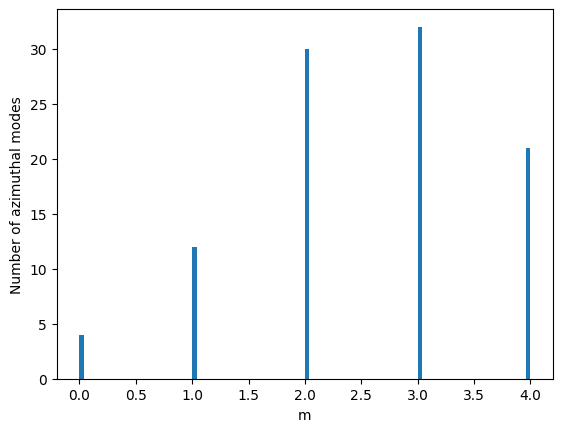
Compare the two waves with and without noise-weighting
[9]:
from few.waveform import FastSchwarzschildEccentricFlux
from few.utils.utility import get_mismatch
noise_weighted_mode_selector_kwargs = dict(sensitivity_fn=sens_fn)
inspiral_kwargs = {
"DENSE_STEPPING": 0, # we want a sparsely sampled trajectory
"buffer_length": int(1e3), # all of the trajectories will be well under len = 1000
}
# keyword arguments for inspiral generator (RomanAmplitude)
amplitude_kwargs = {
"buffer_length": int(1e3), # all of the trajectories will be well under len = 1000
}
# keyword arguments for Ylm generator (GetYlms)
Ylm_kwargs = {
"include_minus_m": False # if we assume positive m, it will generate negative m for all m>0
}
# keyword arguments for summation generator (InterpolatedModeSum)
sum_kwargs = {
"pad_output": False,
}
few_base = FastSchwarzschildEccentricFlux(
inspiral_kwargs=inspiral_kwargs,
amplitude_kwargs=amplitude_kwargs,
Ylm_kwargs=Ylm_kwargs,
sum_kwargs=sum_kwargs,
)
few_noise_weighted = FastSchwarzschildEccentricFlux(
inspiral_kwargs=inspiral_kwargs,
amplitude_kwargs=amplitude_kwargs,
Ylm_kwargs=Ylm_kwargs,
sum_kwargs=sum_kwargs,
mode_selector_kwargs=noise_weighted_mode_selector_kwargs,
)
m1 = 1e6
m2 = 1e1
p0 = 12.0
e0 = 0.3
theta = np.pi / 3.0
phi = np.pi / 4.0
dist = 1.0
dt = 10.0
T = 0.001
wave_base = few_base(m1, m2, p0, e0, theta, phi, dist=dist, dt=dt, T=T, mode_selection_threshold=1e-2)
wave_weighted = few_noise_weighted(
m1, m2, p0, e0, theta, phi, dist=dist, dt=dt, T=T, mode_selection_threshold=1e-2
)
plt.plot(wave_base.real, label="base")
plt.plot(wave_weighted.real, ls='--', label="noise-weighted")
plt.legend()
print("mismatch:", get_mismatch(wave_base, wave_weighted))
print("base modes:", few_base.num_modes_kept)
print("noise-weighted modes:", few_noise_weighted.num_modes_kept)
(CubicSplineInterpolant) Warning: New t array outside bounds of input t array. These points are filled with edge values.
mismatch: 0.010325452679436742
base modes: 19
noise-weighted modes: 24
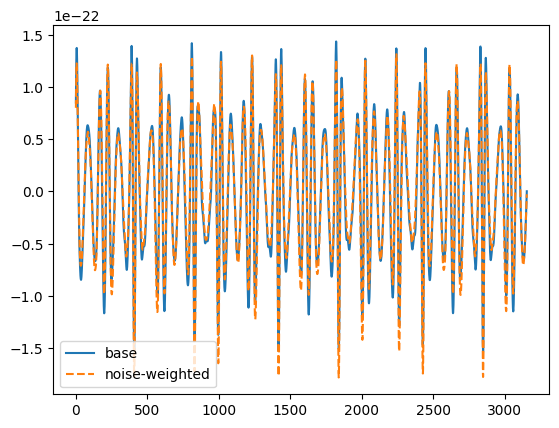
Specific mode selection
The user can also select a specific set of modes to use in the waveform.
[10]:
# l = 2, m = 2 wave
specific_modes = [(2, 2, n) for n in range(-30, 31)]
wave_22 = few_base(
m1, m2, p0, e0, theta, phi, dist=dist, dt=dt, T=T, mode_selection=specific_modes
)
plt.plot(wave_22.real)
print("mismatch with full wave:", get_mismatch(wave_22, wave_base))
(ModeSelector) Warning: Mode selection is large. Instantiate class with mode selection rather than providing it at call time for better performance.
mismatch with full wave: 0.04329518222425399
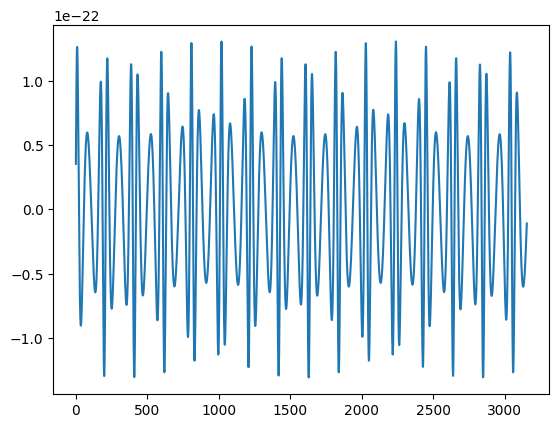
Turn off \((-m, -k, -n)\) modes
By default, symmetry is used to generate \((-m, -k, -n)\) modes from their corresponding \((m, k, n)\) counterparts. To disable this behaviour, provide False to the include_minus_mkn kwarg. This only affects the waveform when mode_selection is a list of specific modes.
[11]:
%matplotlib inline
# l = 2, m = 2 wave without m = -2
specific_modes = [(2, 2, n) for n in range(-30, 31)]
specific_modes_minus_m = [(2, -2, n) for n in range(-30, 31)]
wave_22_pos_m = few_base(
m1,
m2,
p0,
e0,
theta,
phi,
dist=dist,
dt=dt,
T=0.001,
mode_selection=specific_modes,
include_minus_mkn=False,
)
wave_22_minus_m = few_base(
m1,
m2,
p0,
e0,
theta,
phi,
dist=dist,
dt=dt,
T=0.001,
mode_selection=specific_modes_minus_m,
include_minus_mkn=False,
)
plt.plot(wave_22_pos_m.real, label="+m")
plt.plot(wave_22_minus_m.real, label="-m", ls="--")
plt.legend()
print(
"mismatch with 22 wave with + and - m:",
get_mismatch(wave_22_minus_m, wave_22_pos_m),
)
print(
"mismatch with 22 original wave with adding + and - m",
get_mismatch(wave_22, wave_22_pos_m + wave_22_minus_m),
)
(ModeSelector) Warning: Mode selection is large. Instantiate class with mode selection rather than providing it at call time for better performance.
(ModeSelector) Warning: Mode selection is large. Instantiate class with mode selection rather than providing it at call time for better performance.
mismatch with 22 wave with + and - m: 0.9986456689591489
mismatch with 22 original wave with adding + and - m 2.220446049250313e-16
